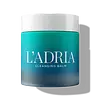What's inside
What's inside
 Key Ingredients
Key Ingredients

 Benefits
Benefits

 Concerns
Concerns

 Ingredients Side-by-side
Ingredients Side-by-side

Helianthus Annuus Seed Oil
EmollientSorbeth-30 Tetraoleate
EmulsifyingRicinus Communis Seed Oil
MaskingCaprylic/Capric Triglyceride
MaskingUndecane
EmollientHydrogenated Rapeseed Oil
EmollientHydrogenated Castor Oil
EmollientHelianthus Annuus Seed Cera
EmollientBisabolol
MaskingSqualane
EmollientAcacia Decurrens Flower Cera
EmollientChondrus Crispus Extract
Skin ConditioningLimonium Vulgare Flower/Leaf/Stem Extract
Skin ConditioningTridecane
PerfumingButylene Glycol
HumectantAmyris Balsamifera Bark Oil
MaskingTocopherol
AntioxidantPentaerythrityl Tetra-Di-T-Butyl Hydroxyhydrocinnamate
AntioxidantBis-Ethylhexyl Hydroxydimethoxy Benzylmalonate
AntioxidantAscorbyl Palmitate
AntioxidantChamomilla Recutita Flower Oil
MaskingStearoyl Glutamic Acid
CleansingPolyhydroxystearic Acid
EmulsifyingJojoba Esters
EmollientPolyglycerin-3
HumectantGlycine Soja Oil
EmollientCI 77007
Cosmetic ColorantHelianthus Annuus Seed Oil, Sorbeth-30 Tetraoleate, Ricinus Communis Seed Oil, Caprylic/Capric Triglyceride, Undecane, Hydrogenated Rapeseed Oil, Hydrogenated Castor Oil, Helianthus Annuus Seed Cera, Bisabolol, Squalane, Acacia Decurrens Flower Cera, Chondrus Crispus Extract, Limonium Vulgare Flower/Leaf/Stem Extract, Tridecane, Butylene Glycol, Amyris Balsamifera Bark Oil, Tocopherol, Pentaerythrityl Tetra-Di-T-Butyl Hydroxyhydrocinnamate, Bis-Ethylhexyl Hydroxydimethoxy Benzylmalonate, Ascorbyl Palmitate, Chamomilla Recutita Flower Oil, Stearoyl Glutamic Acid, Polyhydroxystearic Acid, Jojoba Esters, Polyglycerin-3, Glycine Soja Oil, CI 77007
Alternatives
Ingredients Explained
These ingredients are found in both products.
Ingredients higher up in an ingredient list are typically present in a larger amount.
Glycine Soja Oil comes from the soybean. Glycine Soja is native to eastern Asia.
Soybean oil is an emollient. It is rich in antioxidants and fatty acids including palmitic, stearic, oleic, and linoleic acids.
As an emollient, the fatty acids in soybean oil helps keep your skin soft and hydrated. It does so by creating a film on top that traps moisture in.
Soybean oil is also rich in vitamin E, a potent antioxidant. Vitamin E is also anti-inflammatory and provides a soothing effect.
Studies show soy may help fade hyperpigmentation from UVB. It does so by disrupting the melanin process from UVB induced skin inflammation.
This ingredient may not be malassezia folliculitis, or fungal-acne, safe.
Soybeans are rich in proteins and are part of the legume family. Foods made with soybeans include tofu, soymilk, edamame, miso, and soy sauce.
Learn more about Glycine Soja OilHydrogenated Castor Oil is created by adding hydrogen to castor oil. This helps stabilize the castor oil and raises the melting point. At room temperature, hydrogenated castor oil is solid.
Castor Oil helps moisturize the skin. It is rich in a fatty acid called ricinoleic acid. This fatty acid helps prevent moisture loss on the skin. This helps keep your skin soft and hydrated. Ricinoleic acid also has anti-inflammatory and pain reducing properties.
As a wax-like substance, Hydrogenated Castor Oil acts as an emollient. Emollients help keep your skin stay soft and smooth by creating a barrier. This barrier helps trap moisture.
Hydrogenated Castor Oil may not be fungal-acne safe. We recommend speaking with a professional.
Learn more about Hydrogenated Castor OilSqualane is an emollient that helps the skin hold onto moisture. It's an oily liquid that occurs naturally in certain types of fish and plant oils.
Because squalane boosts hydration in the skin, it also comes with plenty of benefits: it is an antioxidant and can help fight free radicals and skin damage. Squalane is also found to have a detoxifying effect when applied.
Squalane comes from squalene, which occurs naturally within the sebum of our skin. It is one of the oils our skin produces to keep itself hydrated. Squalane is the hydrogenated version of squalene and has a longer shelf life.
Research shows that squalane is non-irritating (even at 100% concentration).
In general, it's a fantastic ingredient. It does a great job at hydrating the skin, and it's suitable for those with sensitive skin.
The source of squalane may impact malassezia / fungal acne. This is because olive oil derived squalane can contain impurities such as fatty acids and plant waxes. Sugarcane derived squalane is recommended for anyone with malassezia concerns.
Is squalane vegan?
This depends on the source. Squalane can be derived from both plants and animals. Most squalane used in skincare comes from plants.
Please note: the source of squalane is only known if disclosed by the brand. We recommend reaching out to the brand if you have any questions about their squalane.
Read more about squalene with an "e".
Is squalane an oil?
Squalane is often called an oil, but it’s technically not; it’s a hydrocarbon, meaning it’s only made of carbon and hydrogen, unlike true oils which are triglycerides made of fatty acids and glycerol.
The term “oil-free” isn’t regulated, so companies can define it however they want. Some exclude all oils, while others just avoid mineral oil or comedogenic oils.
While some people avoid oils thinking they cause breakouts, the right kind of oil (or oil-like ingredient like squalane) can actually help balance and hydrate your skin. It’s worth testing out simple oils or squalane to see what works best for your skin.
Learn more about Squalane